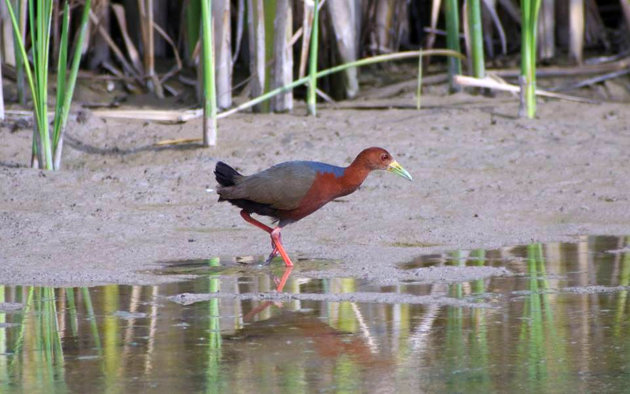 By | Associated Press – Tue, Jul 23, 2013
By | Associated Press – Tue, Jul 23, 2013
ALBUQUERQUE, N.M. (AP) — There’s a frenzy erupting in the birding world, and the Rufous-necked wood-rail is to blame.
Never before has there been a recorded sighting of a Rufous-necked wood-rail in the United States, but for the last two weeks one of the birds has been right at home among the cattails at Bosque del Apache National Wildlife Refuge. Typically, the species is found along the coasts and in tropical forests in Central and South America, far from parched New Mexico.
The sighting has prompted emergency plane reservations and impromptu road trips reminiscent of “The Big Year,” the comedy starring Steve Martin, Jack Black and Owen Wilson that brought to life the annual competition among birders to identify the most species of birds in North America in a year’s time. The difference here is that no one expected they would get to check the wood-rail off their list.
It didn’t take long for Jeffrey Gordon, president of the American Birding Association, and his wife to jump in their car and make the nearly seven-hour drive from Colorado to the southern New Mexico refuge. He said seeing the wood-rail was like being dealt a royal flush.
“Rails kind of have a reputation for being secretive and staying out of sight,” he said. “To see a big, colorful rail and to see it walking around out in the open is just really special. Then, you can add the dimension that it is not only far, but hundreds if not thousands of miles from where you would typically see it.”
The phones have been ringing off the hook at Bosque del Apache since the bird, about the size of a small chicken, was first spotted on the morning of July 7.
Matt Daw, a member of the Bureau of Reclamation’s southwestern willow flycatcher survey team, was getting video of a least bittern at the edge of the marsh when the wood-rail decided to interrupt. Daw was so startled that he turned off the camera after a few seconds.
“The bittern literally got photobombed. This thing came running out of the cattails and the camera kind of shakes. It’s really kind of funny,” said Aaron Mize, the refuge manager. “In the birding world, they’re saying it’s the best photobomb in history.”
Since then hundreds of birders have shown up at the refuge to get a glimpse and take the bird’s picture.
As the sun rises and sets each day, Mize said the boardwalk grows crowded with spectators wanting to see the bird strut out from behind the cattails and hunt for crayfish.
One of the nation’s premier bird-watching spots, the refuge attracts tens of thousands of people over the fall and winter months as throngs of snow geese and sandhill cranes migrate through the Rio Grande Valley. Now, Mize said it’s hard to believe just one bird has captured all the attention in the offseason.
“It’s way cool. We have people flying into Albuquerque every day, from Florida, California, the East Coast,” Mize said. “There are people coming in renting cars and driving down because it’s such a neat and rare event.”
Legendary birder Sandy Komito was there last Wednesday to see the wood-rail. He holds the “big year” record for seeing or hearing the largest number of bird species in North America in a single year.
Refuge officials also recalled the story of an Iowa man who flew into Denver, rented a car and drove down to see the wood-rail only to be disappointed. After driving back to Denver and turning in his rental, he got a phone call that the bird had reappeared. It was enough for him to change his flight, get another rental and drive back down.
“Serious, serious lengths,” Mize said when asked about the efforts by some to see the bird.
“It’s a great thing for birders to be able to check this bird off of their life list where otherwise they would have had to travel to Belize or Costa Rica or South America to see it,” he said.
The big question though is why New Mexico.
Some theorize that it could be climate change, others point simply to the bird’s wings.
“Birds, with their power of flight, do this kind of thing regularly and it’s just one of the really cool delightful things about birding,” Gordon said. “It’s just like this super cool Christmas present when something like this turns up.”

